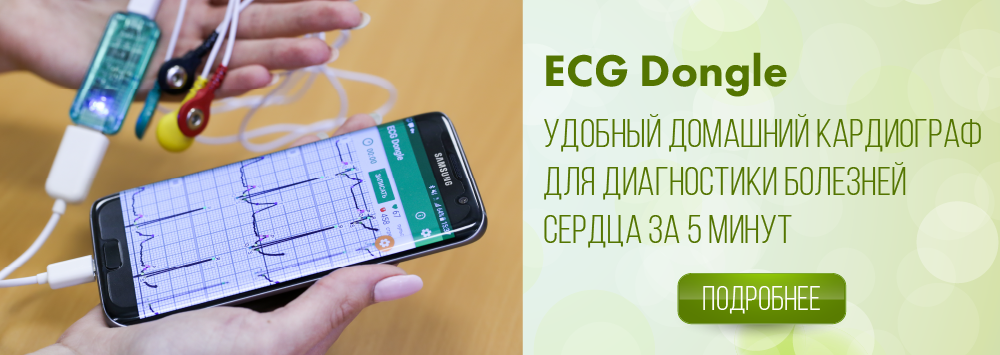Cardiomodule «ECG Dongle»
Cardiomodule "ECG Dongle" is designed to register action potentials of the heart when diagnosing the state of the human cardiovascular system (electrocardiograms, hereinafter ECG), converting them into a digital code and transferring them to the user's mobile device (smartphone or tablet), displaying the ECG on the screen of a mobile device, saving the received data in the memory of the mobile device and transmitting the ECG over a distance.
The indications for the use of the product are suspicions of the presence of pathology or the presence of already identified pathologies of the cardiovascular system.
Areas of use: personal medicine, telemedicine, functional diagnostics, preventive medicine, restorative medicine and balneology, sports medicine, physiotherapy exercises and sports, military, aviation, space and transport medicine, disaster and emergency medicine, cardiology.
The product is intended for all age groups.
There are no contraindications to the use of the product and no side effects.
The product is produced in the following versions:
- Cardiomodule "ECG Dongle" with the ability to register on 6 leads (I, II, III, aVR, aVL, aVF).
- Cardiomodule "ECG Dongle Full" with the ability to register on 12 leads (I, II, III, aVR, aVL, aVF, V1 - V6).
Product specifications are shown in Table 1.
| Parameter name (characteristic) | Parameter value (characteristic) ECG Dongle | Parameter value (characteristic) ECG Dongle Full |
|---|---|---|
| A/D converter | 12 bit/1000 Hz | 12 bit/1000 Hz |
| Number of linearly independent channels | 2 | 8 |
| Number of ECG leads | 6 | 12 |
| Number of cables for connecting electrodes | 4 | 10 |
| The degree of potential risk of using the device | class 2b according to ГОСТ 31508-2012 | class 2b according to ГОСТ 31508-2012 |
| Device safety | ГОСТ Р 50444, ГОСТ Р МЭК 60601-1, ГОСТ Р МЭК 60601-2-25, ГОСТ Р МЭК 60601-2-47, refers to products with an INTERNAL POWER SUPPLY with a working part of the BF type | ГОСТ Р 50444, ГОСТ Р МЭК 60601-1, ГОСТ Р МЭК 60601-2-25, ГОСТ Р МЭК 60601-2-47, refers to products with an INTERNAL POWER SUPPLY with a CF type working part with defibrillation protection |
| Battery and charger | None | None |
| Time for setting the operating mode | Not more than 5 minutes | Not more than 5 minutes |
| Climatic version | УХЛ 4.2 according to ГОСТ 15150 | УХЛ 4.2 according to ГОСТ 15150 |
| Overall dimensions, mm | no more than 69 х 25 х 10 | no more than 90 х 45 х 16 |
| Weight, g | no more than 70 | no more than 340 |
To use the product for its intended purpose, the following equipment is required:
- a smartphone or tablet (an up-to-date list of supported mobile devices is available at: [1]), with the following tactical and technical characteristics (RAM - 15 MB, memory for installing applications - 15 MB, support for OTG standard, operating system - Android at least 4.2 or iOS version up to 12.4 inclusive, to save ECG in PDF format, Android operating system at least 4.4 is required);
- OTG cable (for connecting to Android mobile devices) or Lightling-to-USB adapter (for connecting to Apple mobile devices);
- electrodes (disposable or reusable).
Power is supplied from the battery of a smartphone, tablet or other mobile device that is not connected to an external power supply network, via an OTG cable, a built-in battery is not provided.
ECG visualization occurs on the screen of a smartphone / tablet. To play ECG on a smartphone / tablet, you need to install the “ECG Dongle” software from the GooglePlay or AppStore.
Chronology:
2014 - the decision was made to produce a compact gadget for cardioanalysis,
2015 - first samples and sales. Application for the Useful Model Portable Electrocardiograph [2],
2016 - an application to ФИПС for an industrial design,
2017 - a patent for an industrial design was received [3],
2017 - an application was submitted to Roszdravnadzor,
2019 - received РУ №РЗН2019/8179 [4].

